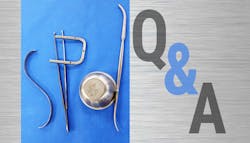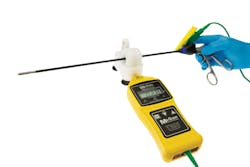Submit your questions: email: [email protected]
Q
We recently had an incident in our operating room (OR) where an OR nurse claimed she got shocked from a piece of electrical equipment. As a result of this incident our safety officer and risk manager have been conducting inspections of everything, including the cleaning and maintenance of any electrical patient care equipment used in the OR and during surgical procedures. They spent time in the sterilization processing department (SPD) observing the reprocessing of various pieces of power-operated instruments and equipment such as drills, arthroscopic shavers, monitors and suction apparatus. While they didn’t find any issues, they expressed some concerns relative to some of our insulated instruments and suggested that as a safety measure I get information on the life of the various cords and instrument coverings. We have never had any incidents with any of these instruments. My staff is very competent and carefully inspects every instrument and, when necessary, utilizes a high-powered, lighted magnifier to see any tiny defects or debris in tight spots. There was no issue found with the piece of equipment the nurse got the minor shock from. Since we have never had such a complaint in the past, I believe that this incident was a fluke and surely unrelated to how things are done in SPD. I’d be interested in your thoughts and suggestions on this matter.
A
Any incident involving an electrical shock in the OR needs a very thorough investigation. Electrical shocks can be caused by defects in medical devices. Defective electrical patient care equipment can pose a serious hazard to the patients and staff. Defective equipment can also cause fires. We are utilizing many more types of electrically-generated surgical devices than ever before. In my observations I have found that preventative measures in the care and handling of many such devices is lacking. Manufacturers’ Instructions for Use (IFUs), professional standards and product warnings are not being followed. Reprocessing staff do not have the resources or necessary tools to do the job correctly. In general, many even are unaware of the widespread use of electrical-driven instruments. They are used in just about every service and specialty, including therapeutic, surgical and diagnostic procedures. There are many different types of insulated instruments and devices utilized in every hospital, every day. Many of these items are complex and have accessory parts including cords and wires. Any surface breaks in their insulation or covering could allow the passage of electrical currents to the patient, healthcare worker and combustible materials. There is no shortage of documented serious injuries, burns, fires and even deaths resulting from electrical leaks in the insulation of electrical surgical and medical devices. Like you, I find a lot of facilities that are only conducting a visual inspection of these complex devices. The visual inspection usually has a limited field of view and mostly focuses on movable parts, tips and ends. Visual inspection alone is not adequate to detect all potential avenues for electrical current leakage. I also see many sterile processing facilities that focus specifically on insulated laparoscopic instrumentation but overlook robotic and bipolar instrumentation and cords.
Various statistics clearly identify the seriousness associated with the improper care, handling and inspection of insulated instruments and devices.
- Of the three million laparoscopic procedures done annually in the U.S. approximately 5.4% will have unintentional tissue burns. That’s 162,000 patients.
- 90% of the instrument is not visualized by the surgeon/surgical team
- 67% of stray electrosurgical burns go unnoticed during surgery
- 25% of the patients who suffer internal injuries stemming from these burns during laparoscopic procedures die
- One in five reusable laparoscopic instruments has insulation failure
- Complications of these internal burns can result in a life-threatening infection
- Even with antibiotic therapy, about 33% of burn patients who develop peritonitis don’t survive.
- Laparoscopy is one of the most common procedures resulting in medical malpractice
The seriousness of this matter resulted in the following FDA warning in 2018:
“Inspect all instruments for evidence of insulation failure (device, wires and connections) prior to use. Do not use if any defects are found.”
AORN recommendations state:
- Insulated devices should be visually examined and tested using equipment designed to detect insulation failures
AST recommendations state:
- An insulation scanner should be used to detect the release of stray electrical energy along the length of the insulation. (1) Cost-effective, user-friendly insulation scanners are commercially available and can be used to test the insulation on reusable and disposable electrosurgical instruments.
AAMI ST 79:
- Instruments should be inspected for flaws, damage, debris, detergent residue, and completeness.
Current AAMI ST 79 2017, which was published before the FDA warning, does not provide specific information for insulation items at this time - that likely could change in pending revisions.
Manufacturers of insulated instrumentation and medical devices clearly detail the necessity to thoroughly inspect the entire insulation in their IFUs.
In conclusion, when reprocessing insulation instrumentation, medical devices and their accessories such as, cords, wires and attachments, it is imperative that the manufacturers’ IFUs be precisely followed, and that the insulation be visually inspected and tested with an insulation testing device (see figure 1).

Ray Taurasi
Ray Taurasi is Principal, Healthcare CS Solutions. His healthcare career spans over five decades as an Administrator, Educator, Technologist and Consultant. He is a member of AORN, SGNA, AAMI and a past president of IAHCSMM. Taurasi has been a faculty member of numerous colleges teaching in the divisions of business administration, nursing, and health sciences. He is the author of numerous articles and textbook chapters; he is a frequent speaker at national and international healthcare conferences.
Note to readers from Ray Taurasi - In 2021, my life’s career path will transition to one of new opportunities and adventures. As a result, after nearly 19 years and 225 CS Solution columns, this edition will be my last.
“All changes, even the most longed for, have their melancholy; for what we leave behind us is a part of ourselves; we must die to one life before we can enter another.”– Anatole France
I wish you and your loved ones a healthy and joyful holiday season and a beautiful New Year! God Speed, Ray
https://www.facebook.com/pages/category/ Local-Business/Healthcare-CS-Solutions-128857 3061153887/ • email: [email protected]






